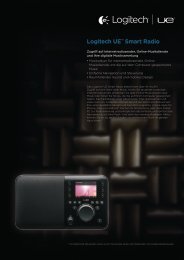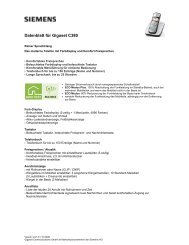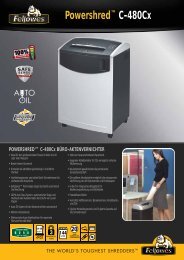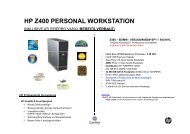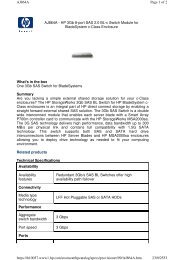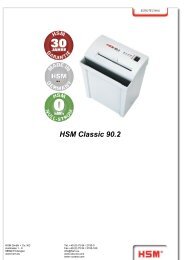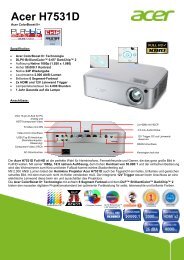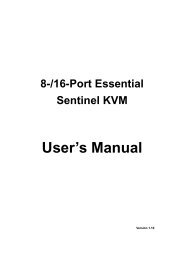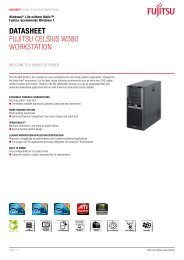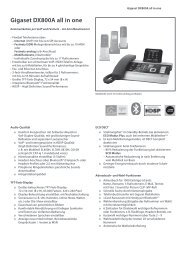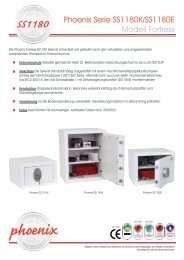4-Port Essential Sentinel VGA KVM & USB Hub User's Manual
4-Port Essential Sentinel VGA KVM & USB Hub User's Manual
4-Port Essential Sentinel VGA KVM & USB Hub User's Manual
You also want an ePaper? Increase the reach of your titles
YUMPU automatically turns print PDFs into web optimized ePapers that Google loves.
4-<strong>Port</strong> <strong>Essential</strong> <strong>Sentinel</strong><br />
<strong>VGA</strong> <strong>KVM</strong> & <strong>USB</strong> <strong>Hub</strong><br />
User’s <strong>Manual</strong><br />
Version 1.0 6/26/2010
4-<strong>Port</strong> <strong>Essential</strong> <strong>Sentinel</strong> <strong>VGA</strong> <strong>KVM</strong> & <strong>USB</strong> <strong>Hub</strong> User’s <strong>Manual</strong><br />
- 1 -<br />
Index<br />
1. INTRODUCTION…………………………………………………………………………………..….2<br />
1.1 FEATURES …………………….…..……………………………………………………………….. .2<br />
1.2 PHYSICAL DIAGRAM…………………………………………..…………………………………….3<br />
1.3 PACKAGE CONTENTS…………………………………...…………………………………………....3<br />
2. SPECIFICATIONS……………………………………………………………………………….…….4<br />
2.1 GENERAL…………………………………………………………………………………………….4<br />
2.2 LED INDICATORS…………………………………………………………………………………….5<br />
3. INSTALL THE 4-PORT ESSENTIAL SENTINEL <strong>VGA</strong> <strong>KVM</strong> & <strong>USB</strong> HUB….….…….………...6<br />
3.1 SYSTEM REQUIREMENTS……………………………………………………………………………...6<br />
3.2 HARDWARE INSTALLATION………………...………………...……………………………………….6<br />
3.3 Notice for Sun Micro System user ………………………………….……………….…………...…..6<br />
3.4 POWERING UP THE SYSTEMS………………………………………………………………………….6<br />
3.5 DRIVER INSTALLATION………………………………………………………………………………..6<br />
3.6 USING THE OSD PROGRAM………………………………………………...………………………….9<br />
4. SWITCHING THE 4-PORT ESSENTIAL SENTINEL <strong>VGA</strong> <strong>KVM</strong> & <strong>USB</strong> HUB……………...….12<br />
4.1 AUTO-SWITCH FUNCTION…….……….………………………………………………………………14<br />
4.2 AUTO-SCAN FUNCTION………………………….………………………………..………………..…14<br />
4.3 SUN MICRO SYSTEM KEY EMULATION…………………………………………………………....…. 16
1. Introduction<br />
4-<strong>Port</strong> <strong>Essential</strong> <strong>Sentinel</strong> <strong>VGA</strong> <strong>KVM</strong> & <strong>USB</strong> <strong>Hub</strong> User’s <strong>Manual</strong><br />
Thank you for purchasing of 4-<strong>Port</strong> <strong>Essential</strong> <strong>Sentinel</strong> <strong>VGA</strong> <strong>KVM</strong> & <strong>USB</strong> <strong>Hub</strong>! You now<br />
have a high quality and durability system to control multiple computers/servers from one<br />
console (PS/2 Mouse, Keyboard and Monitor).<br />
1.1 Features<br />
1. Controls 4 computers from a single console (Keyboard/Mouse) over <strong>USB</strong> connection by<br />
using standard <strong>USB</strong> cables.<br />
2. Supports PS/2 and <strong>USB</strong> Keyboard/Mouse (Hot-Key function supports only on PS/2<br />
Keyboard).<br />
3. Fully compliant with the <strong>USB</strong> 2.0 specification.<br />
4. Supports Windows 98/98SE/2000/ME/XP/Vista/7, Linux, Mac OS9/OSX, SunMicro<br />
Solaris 8 or later (For Sun Micro users, the external power adaptor is necessary<br />
when using the <strong>KVM</strong> Switch).<br />
5. Supports 3 <strong>USB</strong> downstream ports.<br />
6. 4 computers can share 3 <strong>USB</strong> Downstream ports.<br />
7. Supports 3 types of switching: Hardware push button, Hot-Keys on PS/2 keyboard, and<br />
On-Screen-Display (OSD) utility software (for Windows only).<br />
8. OSD and LED display for easy status monitoring.<br />
9. OSD utility indicates:<br />
1. Power status of connected computer(s).<br />
2. Active host computer.<br />
10. Provide HUB switching in independent method or combination with the host switching<br />
(AutoSwitch mode ).<br />
11. Auto-Scan function (Time interval can be adjusted between 5-20 seconds when the<br />
Auto-Scan function is enable).<br />
12. Supports <strong>VGA</strong> resolutions up to 2048x1536 @ 85HZ.<br />
13. Plug and Play (Windows 98/SE users might need your Windows CD to install the HID<br />
driver for <strong>USB</strong> Keyboard/Mouse).<br />
- 2 -
1.2 Physical Diagram<br />
HUB SWITCH LED (GREEN)<br />
1.3 Package Contents<br />
4-<strong>Port</strong> <strong>Essential</strong> <strong>Sentinel</strong> <strong>VGA</strong> <strong>KVM</strong> & <strong>USB</strong> <strong>Hub</strong> User’s <strong>Manual</strong><br />
The product you purchased should contain the equipment and accessories shown as<br />
follows:<br />
PUSH BUTTON<br />
1. A 4-<strong>Port</strong> <strong>Essential</strong> <strong>Sentinel</strong> <strong>VGA</strong> <strong>KVM</strong> & <strong>USB</strong> <strong>Hub</strong>.<br />
2. CD with users manual, On-Screen-Display(OSD) utility.<br />
3. Four sets of <strong>USB</strong>+<strong>VGA</strong> cables.<br />
4. An external power adaptor<br />
PC HOST LED (RED)<br />
- 3 -<br />
HUB LED (GREEN)
2. Specifications<br />
2.1 General<br />
4-<strong>Port</strong> <strong>Essential</strong> <strong>Sentinel</strong> <strong>VGA</strong> <strong>KVM</strong> & <strong>USB</strong> <strong>Hub</strong> User’s <strong>Manual</strong><br />
Specification<br />
Operating Temperature 5~ 40°C<br />
Humidity 0%~80%RH<br />
Cables Included 4<br />
Cable Length 1.8M<br />
Dimensions (LxWxH) 200 x 82 x 44mm<br />
Unit Weight 721g<br />
Number Of Computer Controlled 4<br />
PS/2 Keyboard & Mouse Support Yes<br />
Keyboard Hot-Key Switching Supported Yes (By PS/2 Keyboard only)<br />
<strong>USB</strong> Downstream ports 3<br />
Compliant with <strong>USB</strong> Version <strong>USB</strong>1.0 / <strong>USB</strong>1.1/ <strong>USB</strong> 2.0<br />
Compliant with HID Version <strong>USB</strong> HID 2.0<br />
Power By Host or External Adaptor (Optional)<br />
Bus-Power limit current protection 500mA (When external adaptor applied)<br />
Output Voltage 5V<br />
Output Current 2A<br />
OSD (On Screen Display) Yes (Application Program, Windows only)<br />
Supports resolution Max. Resolution: 2048x1536 @85Hz<br />
Hot Pluggable Yes (<strong>USB</strong> & PS/2)<br />
Auto-Scan function Yes (5 ~20 seconds)<br />
Support Sun Micro Series Yes<br />
Support Mac Series Yes<br />
Support Linux Series Yes<br />
Device driver No<br />
- 4 -
2.2 LED Indicators<br />
Power status LED indicator:<br />
4-<strong>Port</strong> <strong>Essential</strong> <strong>Sentinel</strong> <strong>VGA</strong> <strong>KVM</strong> & <strong>USB</strong> <strong>Hub</strong> User’s <strong>Manual</strong><br />
PC1 HUB LED On (Green): The power is connected and the device is ready to work.<br />
PC Host LED Indicator (Red):<br />
ON (static): Indicates which Host PC is selected and PC is connected.<br />
ON (flash): Indicates which Host PC is selected but PC is not connected.<br />
HUB Switch LED Indicator (Green):<br />
ON (static): <strong>USB</strong> HUB shifts with PC selection<br />
ON( flash): Auto Scan function is on<br />
OFF :<strong>USB</strong> HUB works in the independent mode and does not shift with PC<br />
selection<br />
- 5 -
4-<strong>Port</strong> <strong>Essential</strong> <strong>Sentinel</strong> <strong>VGA</strong> <strong>KVM</strong> & <strong>USB</strong> <strong>Hub</strong> User’s <strong>Manual</strong><br />
3. Install 4-<strong>Port</strong> <strong>Essential</strong> <strong>Sentinel</strong> <strong>VGA</strong> <strong>KVM</strong> & <strong>USB</strong> <strong>Hub</strong><br />
3.1 System Requirements<br />
PC with 1 spare <strong>USB</strong> port and 1 <strong>VGA</strong> port.<br />
Windows 98 or later, Mac OS9/OSX, Solaris 8 (SUN BLADE 100), Linux Kernel 2.3 or<br />
later.<br />
3.2 Hardware Installation<br />
Make sure that the <strong>USB</strong> port of your computer is enabled and working properly.<br />
Connect the <strong>USB</strong> cable Type-A end to the <strong>USB</strong> port of your computer, and the <strong>USB</strong><br />
cable Type-B end to the any available upstream on 4-<strong>Port</strong> <strong>Essential</strong> <strong>Sentinel</strong> <strong>VGA</strong> <strong>KVM</strong><br />
& <strong>USB</strong> <strong>Hub</strong>.<br />
Connect the <strong>VGA</strong> male-to-female cable between the video port of your computer and<br />
video port that corresponds to the <strong>USB</strong> port you selected in step 2.<br />
Repeat steps 1-3 for any other computers you are connecting up and up to 4 computers<br />
can be connected at the same time.<br />
Plug the power adaptor cable into the 4-<strong>Port</strong> <strong>Essential</strong> <strong>Sentinel</strong> <strong>VGA</strong> <strong>KVM</strong> & <strong>USB</strong> <strong>Hub</strong> .<br />
3.3 Notice for Sun Micro System user<br />
Since some Sun Micro system do not support the <strong>USB</strong> 2.0 HUB feature during the<br />
booting period time, if you are using the Sun Micro System, it is possible that you will<br />
see the system show up keyboard detected fail message, screen go to blank for few<br />
minutes, then the login screen will come out.<br />
3.4 Powering up 4-<strong>Port</strong> <strong>Essential</strong> <strong>Sentinel</strong> <strong>VGA</strong> <strong>KVM</strong> & <strong>USB</strong> <strong>Hub</strong><br />
4-<strong>Port</strong> <strong>Essential</strong> <strong>Sentinel</strong> <strong>VGA</strong> <strong>KVM</strong> & <strong>USB</strong> <strong>Hub</strong> supports <strong>USB</strong> plug & play technology.<br />
All the components can be added and removed at any time without the need to shut the<br />
unit down.<br />
3.5 Driver Installation (Windows 98/SE only)<br />
After you connect 4-<strong>Port</strong> <strong>Essential</strong> <strong>Sentinel</strong> <strong>VGA</strong> <strong>KVM</strong> & <strong>USB</strong> <strong>Hub</strong> to your PC, Win 98<br />
will automatically detect the device and prompt for the driver installation. Please install<br />
4-<strong>Port</strong> <strong>Essential</strong> <strong>Sentinel</strong> <strong>VGA</strong> <strong>KVM</strong> & <strong>USB</strong> <strong>Hub</strong> by following the instruction from Step<br />
A-E. Please have your Windows 98 CD ready.<br />
- 6 -
Fig. A<br />
4-<strong>Port</strong> <strong>Essential</strong> <strong>Sentinel</strong> <strong>VGA</strong> <strong>KVM</strong> & <strong>USB</strong> <strong>Hub</strong> User’s <strong>Manual</strong><br />
Fig. B<br />
Fig. C<br />
- 7 -<br />
A. Press “Next” to Continue.<br />
(Ref. Fig. A)<br />
B. Tick “Search for the best<br />
driver for your device” and<br />
press “Next” to continue.<br />
(Ref. Fig. B).<br />
C. Please insert the<br />
“Windows 98” CD into your<br />
CD-ROM drive. Tick<br />
“CD-Rom drive” and press<br />
“Next” to continue.<br />
(Ref. Fig. C)
4-<strong>Port</strong> <strong>Essential</strong> <strong>Sentinel</strong> <strong>VGA</strong> <strong>KVM</strong> & <strong>USB</strong> <strong>Hub</strong> User’s <strong>Manual</strong><br />
Fig. D<br />
Fig. D1<br />
* The driver might be located in a different directory from the figure above.<br />
- 8 -<br />
D. Press “Next” to start the<br />
installation process.<br />
(Ref. Fig. D)<br />
D1. Sometimes Windows<br />
cannot locate the necessary<br />
driver automatically. So you<br />
need to choose “Browse” to<br />
specify the location of the<br />
driver on your “Windows<br />
98” CD manually. *<br />
(Ref. Fig. D1)
4-<strong>Port</strong> <strong>Essential</strong> <strong>Sentinel</strong> <strong>VGA</strong> <strong>KVM</strong> & <strong>USB</strong> <strong>Hub</strong> User’s <strong>Manual</strong><br />
Fig. D2<br />
Fig. E<br />
3.6 Using the OSD program<br />
Fig. F<br />
- 9 -<br />
D2. Press “OK” to continue<br />
(Ref. Fig. D2)<br />
E. Press “Finish” and<br />
Windows has finished<br />
installing the <strong>USB</strong> Human<br />
Interface Device driver for<br />
PS/2 keyboard & mouse.<br />
(Ref. Fig. E)
There are four different statuses:<br />
4-<strong>Port</strong> <strong>Essential</strong> <strong>Sentinel</strong> <strong>VGA</strong> <strong>KVM</strong> & <strong>USB</strong> <strong>Hub</strong> User’s <strong>Manual</strong><br />
a. “No PCs Found” means that 4-<strong>Port</strong> <strong>Essential</strong> <strong>Sentinel</strong> <strong>VGA</strong> <strong>KVM</strong> & <strong>USB</strong> <strong>Hub</strong><br />
Fig. G<br />
cannot acquire the PC status. This is either the PC did not connect or is powered off.<br />
(Ref. Fig. G)<br />
The “Large RED colour 4” and “Small GREEN colour 2” means that 2 PCs are<br />
connected to <strong>Port</strong> 1 and <strong>Port</strong> 4 of your 4-<strong>Port</strong> <strong>Essential</strong> <strong>Sentinel</strong> <strong>VGA</strong> <strong>KVM</strong> & <strong>USB</strong> <strong>Hub</strong><br />
respectively, and you have switched to <strong>Port</strong> 4 already. So the OSD program displayed a<br />
“PC 4 On” underneath. You can click “Small GREEN colour 2” to switch to this available<br />
host. (Ref. Fig. H)<br />
Fig. H<br />
The “Large RED colour 4” and “Small GREEN colour 1, 2, 3” means that four PCs are<br />
connected to <strong>Port</strong> 1 and <strong>Port</strong> 4 of your 4-<strong>Port</strong> <strong>Essential</strong> <strong>Sentinel</strong> <strong>VGA</strong> <strong>KVM</strong> & <strong>USB</strong> <strong>Hub</strong><br />
respectively, and you have switched to <strong>Port</strong> 4 already. So the OSD program displayed a<br />
“PC 4 On” underneath. You can click Small GREEN colour 1, 2 or 3” to switch to a<br />
certain available host. (Ref. Fig. I)<br />
Fig. I<br />
- 10 -
4-<strong>Port</strong> <strong>Essential</strong> <strong>Sentinel</strong> <strong>VGA</strong> <strong>KVM</strong> & <strong>USB</strong> <strong>Hub</strong> User’s <strong>Manual</strong><br />
Fig. J<br />
1. When user click “Hide” button, OSD program window will hide in Taskbar.<br />
2. When user click “Close” button, OSD program will exit.<br />
3. If OSD program hide in Taskbar, user can use mouse right button to show or exit<br />
program.<br />
- 11 -<br />
2<br />
1<br />
3
4-<strong>Port</strong> <strong>Essential</strong> <strong>Sentinel</strong> <strong>VGA</strong> <strong>KVM</strong> & <strong>USB</strong> <strong>Hub</strong> User’s <strong>Manual</strong><br />
4. Switching the 4-<strong>Port</strong> <strong>Essential</strong> <strong>Sentinel</strong> <strong>VGA</strong> <strong>KVM</strong> & <strong>USB</strong><br />
<strong>Hub</strong><br />
4-<strong>Port</strong> <strong>Essential</strong> <strong>Sentinel</strong> <strong>VGA</strong> <strong>KVM</strong> & <strong>USB</strong> <strong>Hub</strong> supports 3 methods for PC selection:<br />
Push button, Hot Keys and OSD. Due to refresh of the video and re-synchronization of<br />
the mouse and keyboard signal, it will take 1-3 seconds configure time after each<br />
switching. This is the normal operation that ensures the proper synchronization is<br />
established.<br />
Note:<br />
The drivers for most <strong>USB</strong> devices (Mass Storage device, CCD Cameras, Scanners,<br />
Card Reader, Printers, e.g.) are required to be shut down or follow the “Safely Remove”<br />
command provided in Windows before you disconnect the device, or else the system<br />
might be hanged. When you switch computers with the <strong>Port</strong> Selection Switch, it is the<br />
equivalent of disconnecting the device. Therefore, if you have peripheral devices (other<br />
than a second keyboard and mouse) connected to these ports, you must be sure to shut<br />
down or safely remove the <strong>USB</strong> driver for them before switching computers.<br />
1. <strong>Manual</strong> Switch by Push-button:<br />
You can switch to any other available active <strong>USB</strong> host connection by simply pushing the<br />
appropriate switch button on 4-<strong>Port</strong> <strong>Essential</strong> <strong>Sentinel</strong> <strong>VGA</strong> <strong>KVM</strong> & <strong>USB</strong> <strong>Hub</strong>. The LED<br />
will be on to indicate which port is currently selected.<br />
2. Hot Key Switch by keyboard:<br />
You can switch to any available active <strong>USB</strong> host connection by using Hot Key directly,<br />
instead of push-button. To send commands to 4-<strong>Port</strong> <strong>Essential</strong> <strong>Sentinel</strong> <strong>VGA</strong> <strong>KVM</strong> &<br />
<strong>USB</strong> <strong>Hub</strong>, must be pressed twice ( Step1 ). Then you can press [1] to [4] (Step<br />
2) to select the Host PC. (Support PS/2 Keyboard only)<br />
*After invoking the Hot Key function with the you must key in the<br />
corresponding active key within 3 seconds for each key press.<br />
( The Scroll LED will start blinking and wait for the following hotkey(Step 2), after<br />
pressing any key or over 3 seconds, the keyboard LED will back to the original<br />
status.)<br />
- 12 -
4-<strong>Port</strong> <strong>Essential</strong> <strong>Sentinel</strong> <strong>VGA</strong> <strong>KVM</strong> & <strong>USB</strong> <strong>Hub</strong> User’s <strong>Manual</strong><br />
Three Steps Hot Key definition table<br />
Step 1 Step2 Action<br />
<strong>USB</strong> HUB Auto-Switch mode<br />
No Scroll Key<br />
Need<br />
*<br />
*<br />
*<br />
*<br />
Switches access to the computer which connecting to host1<br />
Switches access to the computer which connecting to host2<br />
Switches access to the computer which connecting to host3<br />
Switches access to the computer which connecting to host4<br />
- 13 -<br />
Switch next host<br />
Switch the upper one host<br />
Switch the next one host<br />
Switch the HUB to host 1<br />
Switch the HUB to host 2<br />
Switch the HUB to host 3<br />
Switch the HUB to host 4<br />
Start to Auto-Scan<br />
Auto-Scan time interval is 5 seconds<br />
(Available only when Auto-Scan function is ON)<br />
Auto-Scan time interval is 10 seconds<br />
(Available only when Auto-Scan function is ON)<br />
Auto-Scan time interval is 15 seconds<br />
(Available only when Auto-Scan function is ON)<br />
Auto-Scan time interval is 20 seconds<br />
(Available only when Auto-Scan function is ON)<br />
* Notice : To adjust the interval time for Auto Scan, you do not need to press the<br />
SCROLL key, and this can be used only by normal number key.<br />
3. On-Screen-Display (OSD) Switch (Windows only):<br />
You may also use the OSD utility software from the enclosed CD for PC selection.
4.1 Auto-Switch Function:<br />
When Auto-Switch mode is ON:<br />
4-<strong>Port</strong> <strong>Essential</strong> <strong>Sentinel</strong> <strong>VGA</strong> <strong>KVM</strong> & <strong>USB</strong> <strong>Hub</strong> User’s <strong>Manual</strong><br />
When Auto-Switch mode activates, 4-<strong>Port</strong> <strong>Essential</strong> <strong>Sentinel</strong> <strong>VGA</strong> <strong>KVM</strong> & <strong>USB</strong> <strong>Hub</strong> will<br />
shift Host PC with the HUB together in certain time interval. This is convenient for you to<br />
let the <strong>USB</strong> device always follow the host.<br />
There are two ways to activate HUB Auto-Switch mode :<br />
A). By Hot key [Scroll+Scroll][H] : Please refer to the hotkey table in page 14.<br />
B). Press any Host push button for 3 seconds when the Auto-Switch mode is OFF.<br />
The HUB SWITCH LED will be on and static when Auto-Switch mode is on.<br />
When Auto-Switch mode is OFF:<br />
You must switch the hub to the new target host by hotkey.<br />
There are two ways to turn off HUB Auto-Switch mode :<br />
A). By Hot key [Scroll+Scroll][H] : please refer to the hotkey table in page 14.<br />
B). Press any Host push button for 3 seconds when the Auto-Switch mode in ON.<br />
The HUB SWITCH LED will be on but flash when Auto-Switch mode in off.<br />
4.2 Auto-Scan Function:<br />
1.Auto-Scan ON : When you enable Auto-Scan mode by pressing the<br />
[Scroll]+[Scroll]+[S], 4-<strong>Port</strong> <strong>Essential</strong> <strong>Sentinel</strong> <strong>VGA</strong> <strong>KVM</strong> & <strong>USB</strong> <strong>Hub</strong> will shift through all<br />
the ports and display them on the monitor . Each port is displayed in 5,10,15,20<br />
seconds before shifting to the next. You can press the normal numeric key 1,2,3,4 to<br />
adjust the interval time (Please refer to the hotkey table in page 14).<br />
Note:<br />
The mouse and keyboard will be disabled in this mode. This is necessary to prevent<br />
errors such as erratic movement and wrong characters to display when using the mouse<br />
or keyboard in accident.<br />
- 14 -
2.Auto-Scan Interval timer<br />
4-<strong>Port</strong> <strong>Essential</strong> <strong>Sentinel</strong> <strong>VGA</strong> <strong>KVM</strong> & <strong>USB</strong> <strong>Hub</strong> User’s <strong>Manual</strong><br />
[n] *(Available only when Auto-Scan function is ON)<br />
You can change the Auto-Scan interval by pressing the appropriate number key or the<br />
number pad keys.<br />
n Scan Interval<br />
[1] 5 sec.<br />
[2] 10 sec.<br />
[3] 15 sec.<br />
[4] 20sec.<br />
3.Auto-Scan OFF : When the 4-<strong>Port</strong> <strong>Essential</strong> <strong>Sentinel</strong> <strong>VGA</strong> <strong>KVM</strong> & <strong>USB</strong> <strong>Hub</strong> is in<br />
Auto-Scan mode, you can use these methods to stop the Auto-Scan :<br />
Press SPACE key : 4-<strong>Port</strong> <strong>Essential</strong> <strong>Sentinel</strong> <strong>VGA</strong> <strong>KVM</strong> & <strong>USB</strong> <strong>Hub</strong> will stop the<br />
Auto-Scan operation by pressing Space key and stay in the current scanning port.<br />
Press the any other key on the key board : This will cause the 4-<strong>Port</strong> <strong>Essential</strong><br />
<strong>Sentinel</strong> <strong>VGA</strong> <strong>KVM</strong> & <strong>USB</strong> <strong>Hub</strong> stop the Auto-Scan operation and jump back to<br />
original active pc<br />
- 15 -
4-<strong>Port</strong> <strong>Essential</strong> <strong>Sentinel</strong> <strong>VGA</strong> <strong>KVM</strong> & <strong>USB</strong> <strong>Hub</strong> User’s <strong>Manual</strong><br />
4.3 Sun Micro System Function Key Emulation:<br />
There are 16 special functions on the Sun Micro system keyboard, the 4-<strong>Port</strong><br />
<strong>Essential</strong> <strong>Sentinel</strong> <strong>VGA</strong> <strong>KVM</strong> & <strong>USB</strong> <strong>Hub</strong> can emulate these function keys via the<br />
PS/2 keyboard ( it won’t work on the <strong>USB</strong> keyboard ). Here is the mapping table for<br />
these function operation. To active these emulation on the PS/2 keyboard, you have<br />
to press the LEFT Window KEY first ( this key usually is located between the left [Ctrl]<br />
and left [Alt]), then choice the second relative key.<br />
Sun Micro System<br />
Function Key<br />
PS/2 Keyboard<br />
Stop L_Win & L_Alt<br />
Props L_Win & L_Ctrl<br />
Compose L_Win & L_Shift<br />
Front L_Win & F1<br />
Open L_Win & F2<br />
Find L_Win & F3<br />
Again L_Win & F4<br />
Undo L_Win & F5<br />
Copy L_Win & F6<br />
Paste L_Win & F7<br />
Cut L_Win & F8<br />
Help L_Win & F11<br />
Power L_Win & F12<br />
Mute L_Win & 1<br />
Volume Down L_Win & 2<br />
Volume UP L_Win & 3<br />
- 16 -
Disclaimer<br />
4-<strong>Port</strong> <strong>Essential</strong> <strong>Sentinel</strong> <strong>VGA</strong> <strong>KVM</strong> & <strong>USB</strong> <strong>Hub</strong> User’s <strong>Manual</strong><br />
Information in this document is subject to change without notice. The manufacturer does not make any representations or<br />
warranties (implied or otherwise) regarding the accuracy and completeness of this document and shall in no event be liable for<br />
any loss of profit or any other commercial damage, including but not limited to special, incidental, consequential, or other<br />
damages.<br />
No part of this document may be reproduced or transmitted in any form by any means, electronic or mechanical, including<br />
photocopying, recording or information recording and retrieval systems without the express written permission of the<br />
manufacturer.<br />
All brand names and product names used in this document are trademarks, or registered trademarks of their respective holders.<br />
FCC Statement<br />
This device generates and uses radio frequency and may cause interference to radio and television reception if not installed and<br />
used properly. This has been tested and found to comply with the limits of a Class B computing device in accordance with the<br />
specifications in Part 15 of the FCC Rules. These specifications are designed to provide reasonable protection against such<br />
interference in a residential installation. However, there is no guarantee that interference will not occur in a particular installation.<br />
If this device does cause harmful interference to radio or television reception, which can be determined by plugging the device<br />
in and out, the user can try to correct the interference by one or more of the following measures:<br />
Reorient or relocate the receiving antenna.<br />
Increase the separation between the device and receiver.<br />
Connect the computer into an outlet on a circuit different from that to which the receiver is connected.<br />
Consult the dealer or an experienced radio/TV technician for help.<br />
- 17 -
檔名: inmac KC241 manual Ve-1-0_20100707.doc<br />
目錄: D:\國外客戶\DE-imac\package\user manual<br />
範本: C:\Documents and Settings\carol.chen\Application<br />
Data\Microsoft\Templates\Normal.dot<br />
標題: USER’S MANUAL<br />
主旨:<br />
作者: freddie<br />
關鍵字:<br />
註解:<br />
建立日期: 2010/7/7 10:18:00 AM<br />
修訂版編號: 2<br />
前次更新日期: 2010/7/7 10:18:00 AM<br />
前次存檔人員: carol.chen<br />
編輯總時間: 4 分鐘<br />
最後列印在: 2010/10/27 8:10:00 PM<br />
最後列印的字數<br />
頁數: 18<br />
字數: 2,477 (約)<br />
字元數: 14,123 (約)



